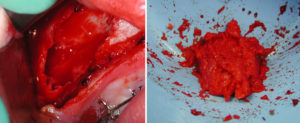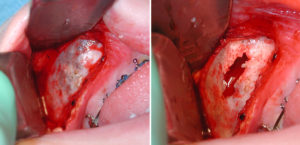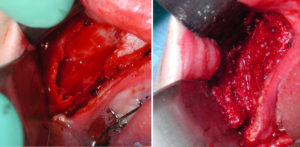Background: The aneurysmal bone cyst is a well known but rare bony lesion that is known to affect the lower jaw. Its name is actually a misnomer as it is neither a cyst or a a vascular aneurysm. Rather it is an osteolytic bone lesion which is characterized by being comprised of serum or a sponge-like blood material that usually contains osteoclast-like giant cells. It has a wide variability in presentation from a small asymptomatic lesion that is coincidentally found on an x-ray to a much larger expansile lesion that has eroded through the outer cortex causing some external facial deformity.
The unusual nature of the aneurysmal bone cyst has led to debate about its origin. The historic explanation is that it was caused by increased venous pressure in the bone and subsequent vascular rupture…hence its traditional name. More contemporary thought has been modified to be an arteriovenous malformation within the bone. While it can occur independently, it is also known to be caused from pre-existng bone lesions such as giant cell tumors, osteoblastomas and fibrous dysplasia.



Case Highlights:
1) Aneurysmal bone cysts are not uncommon in the lower jaw and can present as an external facial swelling along the jawline.
2) An expansile bony jaw lesion that is filled with serous or bloody fluid indicates an aneurysmal bone cyst.
3) Enucleation and allogeneic bone grafting is an effective treatment for this type of osteolytic jaw lesion.
Dr. Barry Eppley
Indianapolis, Indiana






